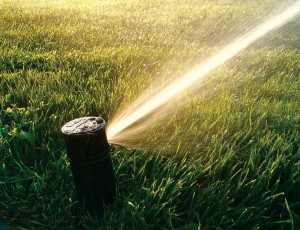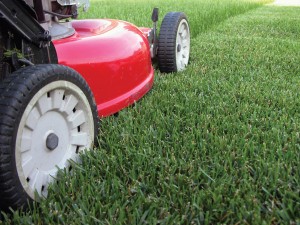Lawn Tips
Proper Watering
Keeping your lawn thick, green and healthy means doing several things right. One of the most important is making sure there’s enough moisture to maintain growth.

Nature’s rainfall schedule is not dependable. Some additional watering is almost always necessary, at least during the hotter and drier parts of the year, to avoid drought stress. If your lawn looks dry, it is dry. One basic rule is: Water your lawn when the least amount will be lost. Avoid watering in the heat of the day to make sure your water goes down to the roots instead of going up as vapor. Also avoid watering when windy conditions will affect even watering or cause you to water your neighbor’s lawn instead of your own.
When you water, saturate the soil to a depth of 6″ to 8″. Frequent, shallow watering causes the grass to send roots to the surface for water, where they suffer more quickly during dry, hot spells. Also be sure to put down extra water along curbs and pavement, because these areas heat up much more and dry out much faster.
Proper Mowing
Proper mowing is critical to keeping your lawn healthy and looking good. There are three things you can do to keep your lawn “a cut above” the rest:

MOW HIGH ENOUGH
The basic rule is: The hotter the weather, the higher you should mow. Higher mowing promotes deeper roots, prevents water loss by shading the soil, and reduces weeds by preventing sunlight from warming weed seeds. Taller grass also cools the soil and reduces heat stress. In most cases, the lawn should be 2 ½- 3 inches after it has been mowed.
MOW OFTEN ENOUGH
Be sure that no more than 1/3 of the total grass blade is removed in any one mowing. Mowing too short removes too much of the green part of the plant, leaving stalky-looking crowns and stems. This gives the lawn a brown, scalped look and weakens the grass. Recovering from even a single “scalping” sets the lawn’s growth back many weeks.
KEEP MOWER BLADES SHARP
Dull mower blades can rip and shred the tips of your grass blades, turning them a bleached, tan color and leaving the whole lawn looking brown. For best results, sharpen mower blades several times per year. If you have a large lawn, sharpen them once a month during the mowing season.
After Seeding Care
With new seed, you should use light, frequent watering (at least once a day). You should water enough to keep the top 1″ to 2″ of soil continuously moist. If seedbeds are allowed to dry out, germination can be reduced considerably.
Keep up the frequent watering even after you see the first grass. If your seed mixture contained several kinds of grasses, you may be seeing the first kind. The other grasses will continue to germinate for three to four more weeks. Plus, young grass seedlings without many roots still need your help with water.
